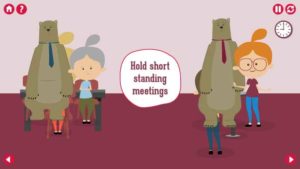- Summarising the health risks linked to physical inactivity and sedentary behaviour
- Reviewing current guidance on sitting at work (as at April 2018)
- Considering what future guidance on prolonged sitting at work might require; and
- Explaining the commercial rationale for the More More at Work course
Physical Activity at Work
Insufficient physical activity (IPA) is a worldwide problem which can lead to significant health issues including high blood pressure, coronary heart disease, stroke, diabetes, breast and colon cancer, and depression.IPA has been identified by the World Health Organization (WHO) as the fourth leading risk factor for global mortality. IPA is partly attributable to:• inadequate levels of activity during leisure time; and • an increase in sedentary behaviour (sitting or lying down while awake) during occupational and domestic activities. Member states including the U.K. have adopted WHO guidelines on physical activity for different age groups. U.K.Chief Medical Officers issued their revised Physical Activity Guidelines in September 2019. Promoted via numerous public health organisations including the NHS, broadly speaking this advocates:• regular moderate and/or vigorous aerobic activity, and strength exercises; and • reducing sedentary behaviour, both at work and during leisure time echo3education have developed a short online ‘awareness’ training course aimed at desk-based workers to help them understand how much physical activity at work is required.The course helps employers combat risks associated with sedentary behaviour in the workplace, a serious topic usually not covered by DSE Training in a depth proportionate to the risks – DSE courses instead tend to focus on improving ergonomics and protecting eyesight.The Move More at Work course is designed to address this gap by complementing any existing DSE training.Why tackle the risks of sedentary behaviour?
Physical inactivity is the 4th biggest killer on the planet (World Health Organization). For good health we need to be physically active and reduce our sedentary behaviour (sitting or lying down for long periods while awake). While sedentary behaviour happens everywhere, prolonged periods of sitting at work, which expose staff to risks, need to be properly managed. This includes providing employees with clear information about the health risks, and control measures available to combat them.Besides the obvious benefits of safeguarding the health and wellbeing of workers, tackling risks your staff are exposed to at work is a legal requirement that also comes with financial benefits.Legal Requirement
Employers have legal obligations to address risks to health and safety at work including:- general duties under the Health and Safety at Work Act.1974 (the Act) to ensure the health, safety and welfare of staff and non-employees
- duties under the Act to provide staff with information, instruction, and training necessary to ensure health, safety and welfare
- duties under the Management of Health and Safety at Work Regulations 1999 to assess risks to health and safety, provide staff with information about those risks and any control measures implemented to manage risks.
Financial Benefits of Physical Activity at Work
Moving more at work not only helps improve general health, it also reduces the risk of musculoskeletal disorders and workplace stress, which together account for over 80% of work-related ill-health in the UK (HSE 16/17). This amounts to over 20 million working days lost each year, at an annual cost to business of around £2 billion.Many companies already understand the health and business benefits of having desk-based staff move more at work, investing heavily in solutions such as sit/stand furniture. While this can be useful for some, it is expensive, typically costing several hundred pounds.But small changes can also make a big difference. For a tiny fraction of the cost of procuring sit/stand furniture, the Move More at Work course provides staff with information about the risks of physical inactivity and sedentary behaviour. It also introduces them to a wide variety of simple free and low-cost ways to break up long periods of sitting.Physical Inactivity – An Introduction
Insufficient physical activity (IPA) is a worldwide problem which can lead to significant health issues, including high blood pressure, coronary heart disease, stroke, diabetes, breast and colon cancer, and depression. IPA has been identified by the World Health Organization (WHO) as the fourth leading risk factor for global mortality.IPA is partly attributable to:• inadequate levels of activity during leisure time; and• an increase in sedentary behaviour (sitting or lying down while awake) during occupational and domestic activities.Member states, including the UK, have adopted WHO guidelines on physical activity for different age groups. Promoted via numerous public health organisations including the NHS, broadly speaking the guidelines advocate:• regular moderate and/or vigorous aerobic activity, and strength exercises; and• reducing sedentary behaviour, both at work and during leisure time.Sedentary Behaviour at Work
While the link between IPA and ill-health is long established, an increasing number of studies in more recent years have highlighted the dangers of sedentary behaviour – sitting or lying down for long periods while awake. Some commentators have even described prolonged sitting as the ‘new cancer’ or the ‘new smoking’.Clearly, sedentary behaviour happens in a variety of settings – during leisure time, while commuting and in the workplace. But our increasing reliance on technology in the workplace – predominantly used at a desk – can condition users to sit for long periods and over time this can have a serious negative impact on health. Additionally, as the workplace itself has evolved, staff are more likely to be working remotely away from the office with reduced direct supervision.The DSE Regulations
The Health and Safety (Display Screen Equipment) Regulations 1992 were amended by the Health and Safety (Miscellaneous Amendments) Regulations 2002 (the DSE Regulations) and aim to reduce the health risks associated with computer use at work. The DSE Regulations and the accompanying Health and Safety Executive (HSE) Guidance would therefore seem a natural place for information and guidance on sedentary working risks to be contained.However, research on (and awareness of) the health risks linked to prolonged sitting has developed significantly since the last major update to the Regulations and Guidance in 2002. As such, the focus of both the legislation and Guidance remains on minimising the following health risks:• musculoskeletal disorders• visual fatigue• mental stress and anxietyRegulation 4 of the DSE Regulations does require employers to plan the work activities of their DSE users, and this enables postural variations as their computer tasks are broken up by other types of work. HSE Guidance suggests short, frequent interruptions (e.g. 5-10 minutes per hour of computer use) are preferable to longer, more infrequent interruptions. While a welcome consequence of this provision may be that computer users move more often, by themselves the Regulations do not provide sufficient information or guidance on the importance of activity and movement for staff with sedentary jobs. And in 2018, many staff have few or no alternatives to their computer work.Guidance for businesses physical activity at work
 In the absence of any ‘official’ guidance on sedentary working, an Expert Statement commissioned by Public Health England and The Active Working Community Interest Company was published in the British Journal of Sports Medicine in June 2015. To reduce sitting time, one of the recommendations within the report proposes that staff in desk-based roles should aim for at least 2 hours of standing or light activity during working hours, building up to 4 hours. Adjustable sit/stand desks or workstations are recommended as a method of facilitating this.No doubt mindful of the impact of such a dramatic change in working practice, not to mention potential costs associated with procuring sit/stand furniture, business groups such as the CBI gave the Expert Statement a lukewarm response.
In the absence of any ‘official’ guidance on sedentary working, an Expert Statement commissioned by Public Health England and The Active Working Community Interest Company was published in the British Journal of Sports Medicine in June 2015. To reduce sitting time, one of the recommendations within the report proposes that staff in desk-based roles should aim for at least 2 hours of standing or light activity during working hours, building up to 4 hours. Adjustable sit/stand desks or workstations are recommended as a method of facilitating this.No doubt mindful of the impact of such a dramatic change in working practice, not to mention potential costs associated with procuring sit/stand furniture, business groups such as the CBI gave the Expert Statement a lukewarm response.Revised HSE Guidance on Sitting at Work
The Health and Safety Executive have identified musculoskeletal disorders as one of their three health priorities (alongside work-related stress and occupational lung disease). Their Strategy Plan for tackling this issue, finalised in autumn 2017, contains a commitment to update their guidance on the use of screen-based equipment and the relevant impacts of sedentary working. Public policy on sedentary working will be informed by the HSE’s Workplace Health Expert Committee who are expected to publish their own paper on the topic in the coming months.We anticipate that new HSE guidance on sedentary working will follow, and could contain recommendations which are less radical than those put forward by the Expert Statement.For example, new HSE guidance on sitting at work may:• require employers to provide staff with information about the health risks associated with sedentary behaviour• avoid setting prescriptive goals for sedentary staff to achieve, instead encouraging employers to identify and highlight opportunities for standing and movement where they exist• recommend employers set and communicate clear policies about standing and movement at work• outline different ways of encouraging activity, standing and movement at work
Public policy on sedentary working will be informed by the HSE’s Workplace Health Expert Committee who are expected to publish their own paper on the topic in the coming months.We anticipate that new HSE guidance on sedentary working will follow, and could contain recommendations which are less radical than those put forward by the Expert Statement.For example, new HSE guidance on sitting at work may:• require employers to provide staff with information about the health risks associated with sedentary behaviour• avoid setting prescriptive goals for sedentary staff to achieve, instead encouraging employers to identify and highlight opportunities for standing and movement where they exist• recommend employers set and communicate clear policies about standing and movement at work• outline different ways of encouraging activity, standing and movement at workMove More at Work e-learning
 This concise e-learning course has been developed to provide users with clear information about the serious health risks associated with inactivity generally, and in particular prolonged sitting while at work. Users are given examples of different ways of introducing more activity and movement in the workplace, and asked to consider which methods might work best for them personally.A deliberately irreverent visual approach has been adopted to provide a contrast with the text and voice-overed information (which by its nature can be sobering), and to help hold the user’s attention throughout the course.While sit/stand furniture is acknowledged as an effective way of encouraging movement and postural changes, a key objective of the course is to highlight other free and low-cost methods of reducing prolonged periods of sitting.
This concise e-learning course has been developed to provide users with clear information about the serious health risks associated with inactivity generally, and in particular prolonged sitting while at work. Users are given examples of different ways of introducing more activity and movement in the workplace, and asked to consider which methods might work best for them personally.A deliberately irreverent visual approach has been adopted to provide a contrast with the text and voice-overed information (which by its nature can be sobering), and to help hold the user’s attention throughout the course.While sit/stand furniture is acknowledged as an effective way of encouraging movement and postural changes, a key objective of the course is to highlight other free and low-cost methods of reducing prolonged periods of sitting.End of the article covering the Benefits of Physical Activity at Work
on sitting at work move more at work happy healthy here move more at wok









